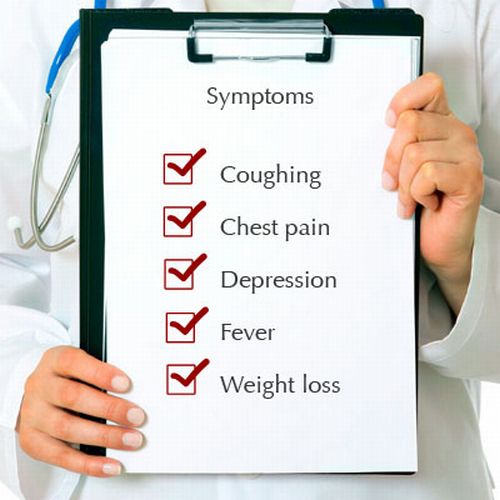COPD is an umbrella term that covers a number of pulmonary disorders including chronic bronchitis and emphysema. It’s caused due to a number of environmental and lifestyle factors. It does not present itself instantly and there is a gradual decline in health many times over years. The initial symptoms – cough, wheezing, shortness of breath are mild and develop over time. Although these symptoms can be indicative of other illnesses, a visit to your local practitioner can resolve any doubt. The main symptoms of COPD are listed below.

1. Persistent cough
The most common and early symptom is cough that persists over a period of time. The cough can be indicative of either chronic bronchitis or emphysema. Chronic bronchitis is a result of inflammation of the bronchial tubes resulting in mucus production. In cases of chronic bronchitis, early morning cough with mucus/phlegm production is a warning sign. The mucus is generally thick and clear. In emphysema, the lung alveolar walls are damaged, the alveoli lose their elasticity and are unable to function, resulting in less oxygen delivered to the tissues and trapping of air within the airways. A dry cough is symptomatic of emphysema as the lungs clear out the deoxygenated blood.
2. Wheezing
In COPD patients, wheezing is the sound when air passes through the blocked and narrowed airways. The narrowing may be due to emphysema or bronchial inflammation. Wheezing is a high pitched whistle like sound that generally occurs during exhalation. Depending on the severity of the diseases, the wheezing sounds may be heard without the use of a stethoscope. Initially, wheezing may occur only during physical activity or on exertion, but as the disease progresses, wheezing may be heard even while sitting or sleeping. Bronchial dilators are effective remedies to improve wheezing.
3. Pulmonary Infection
Pulmonary infections can lead to COPD exacerbation requiring hospitalization as the only recourse available. The infections may be due to a bacterial or a viral agent and even the common cold can be debilitating to a COPD patient. In a chest infection, the mucus production increases and has a yellowish – green color. This worsens the cough and exacerbates shortness of breath that is normally seen in COPD. A chest infection can prove to be life-threatening and needs to be treated medically on an urgent basis. Such infections may develop into pneumonia and can prove to be fatal.
4. Tightness in the Chest
Since COPD patients are susceptible to pulmonary infections, tightness in the chest may be due to an infection that develops in the lungs or may be due to the increased mucus secretion that’s characteristic of COPD. It can be described as a feeling of increased pressure internally within the thoracic region making it difficult to breathe normally. Deep breathing may be painful and shallow, short breaths try to compensate for the reduced air flow. Medications like aerosol sprays and using breathing techniques may reduce the symptoms.
5. Haemoptysis and Chest pain
It is not uncommon to experience chest pain accompanied by small amounts of blood in sputum (haemoptysis). The pain is felt in the chest region is termed pleuritic chest pain and is not symptomatic of a cardiac problem. The chest pain is due to the increased pressure in the airways and makes deep breathing painful. It’s a result of the damage to the alveoli and destruction of alveolar walls. However, haemoptysis in COPD patients may signal lung cancer. Any sign of blood streaked sputum and chest pain should warrant immediate medical attention
6. Fatigue
Fatigue may be one of the most poorly understood symptoms of COPD. Fatigue is different from tiredness and may not usually be spotted as an indicator of a pulmonary disorder. In COPD, the capacity of the lungs to deliver oxygen to the tissues is restricted and resulting in oxygen deprivation leading to fatigue. The level of fatigue experienced depends on the severity of COPD and is associated with exacerbation of COPD. As the disease progresses, fatigue experienced increases limiting ones activity further. One can deal with fatigue by getting adequate sleep, taking short breaks between daily tasks, exercising on a daily basis, learning different relaxation techniques and maintaining a healthy diet.
7. Weight Loss
Weight loss in COPD patients is not understood very well but one of the main reasons is usually a loss of appetite. The physical act of eating, chewing and swallowing causes tiredness and COPD patients are unable to cope with the resulting fatigue. Others reasons for weight loss could be depression, lack of appetite due to medication and muscle loss due to lack of physical activity and exercise especially in patients suffering from emphysema. An unbalanced diet and poor nutrition may also be a factor in weight loss. Resting before meals, eating several short meals spaced throughout the day and choosing diets specifically designed for COPD patients may improve appetite and curb weight loss.
Other symptoms include barrel chest appearance, cyanosis and oedema in extremities during advanced stages of COPD. COPD results in impaired breathing lowered quality of life and may remain undetected over time. Not all COPD patients present all of the above symptoms. Consult with your practitioner and get a right diagnosis and treatment plan for yourself. Regular checkups should form part and parcel of a healthy lifestyle.




